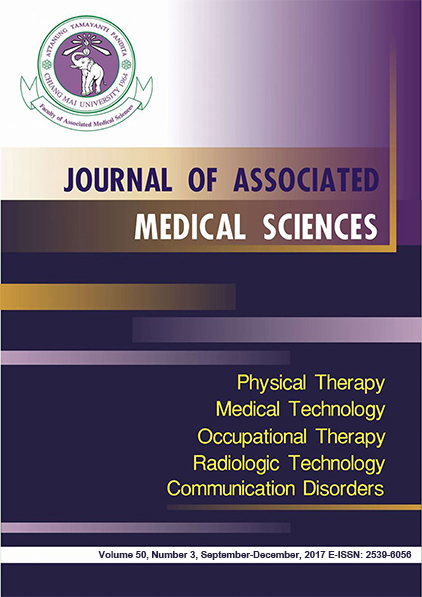A comparison of thickness of the serratus anterior muscle during contraction between dominant and non-dominant hands in healthy individuals
Main Article Content
Abstract
Background: Serratus anterior muscle is an important muscle that helps to increase stability and to control movements of the scapula. Whether there is influence of hand dominance on thickness of the serratus anterior during contraction is unknown.
Objectives: To compare thickness of the serratus anterior muscle between the dominant and non-dominant hands during muscle contraction.
Materials and methods: Twenty healthy men were recruited for the study. The thickness of the serratus anterior muscle was bilaterally measured in a wall push-up position using ultrasound imaging. Measurement of the serratus anterior thickness was performed three times using Image J software.
Results: The serratus anterior thickness on the dominant hand was significantly greater than that on the non-dominant hand (p<0.05).
Conclusion: Hand dominance has an influence on the thickness of the serratus anterior muscle during contraction. This should be taken into consideration in future research when determining the serratus anterior muscle.
Article Details
Personal views expressed by the contributors in their articles are not necessarily those of the Journal of Associated Medical Sciences, Faculty of Associated Medical Sciences, Chiang Mai University.
References
2. Voight ML, Thomson BC. The Role of the Scapula in the Rehabilitation of Shoulder Injuries. J Athl Train 2000; 35: 364-72.
3. Ludewig PM, Cook TM. Alterations in shoulder kinematics and associated muscle activity in people with symptoms of shoulder impingement. Phys Ther 2000; 80: 276-91.
4. Helgadottir H, Kristjansson E, Einarsson E, Karduna A, Jonsson H, Jr. Altered activity of the serratus anterior during unilateral arm elevation in patients with cervical disorders. J Electromyogr Kinesiol 2011; 21: 947-53.
5. Lieber RL, Friden J. Functional and clinical significance of skeletal muscle architecture. Muscle Nerve 2000; 23: 1647-66.
6. Schneebeli A, Egloff M, Giampietro A, Clijsen R, Barbero M. Rehabilitative ultrasound imaging of the supraspinatus muscle: Intra- and interrater reliability of thickness and cross-sectional area. J Bodyw Mov Ther 2014; 18: 266-72.
7. Sipila S, Suominen H. Quantitative ultrasonography of muscle: Detection of adaptations to training in elderly women. Arch Phys Med Rehabil 1996; 77: 1173-8.
8. O’Sullivan C, Bentman S, Bennett K, Stokes M. Rehabilitative ultrasound imaging of the lower trapezius muscle: technical description and reliability. J Orthop Sports Phys Ther 2007; 37: 620-6.
9. Hodges PW, Pengel LH, Herbert RD, Gandevia SC. Measurement of muscle contraction with ultrasound imaging. Muscle Nerve 2003; 27: 682-92.
10. Artul S, Habib G. The importance of dynamic ultrasound in the diagnosis of tibialis anterior muscle herniation. Crit Ultrasound J 2014: 14. doi:10.1186/s13089-014-0014-0.
11. Talbott NR, Witt DW. Ultrasound examination of the serratus anterior during scapular protraction in asymptomatic individuals: reliability and changes with contraction. PM&R 2014; 6: 227-34. doi:10.1016/j.pmrj.2013.09.003.
12. Laubach LL. Comparative muscular strength of men and women: a review of the literature. Aviat Space Environ Med 1976; 47: 534-42.
13. Lindle RS, Metter EJ, Lynch NA, Fleg JL, Fozard JL, Tobin J, et al. Age and gender comparisons of muscle strength in 654 women and men aged 20-93 yr. J Appl Physiol 1997; 83: 1581-7.
14. Uthaikhup S, Wannaprom N, Kummaung P. Effects of gender and hand dominance on size of the lower trapezius muscle. Muscle Nerve 2015; 52: 576-9.
15. Springer BA, Mielcarek BJ, Nesfield TK, Teyhen DS. Relationships among lateral abdominal muscles, gender, body mass index, and hand dominance. J Orthop Sports Phys Ther 2006; 36: 289-97.
16. Ludewig PM, Hoff MS, Osowski EE, Meschke SA, Rundquist PJ. Relative balance of serratus anterior and upper trapezius muscle activity during push-up exercises. Am J Sports Med 2004; 32: 484-93.
17. Rho M, Spitznagle T, Van Dillen L, Maheswari V, Oza S, Prather H. Gender differences on ultrasound imaging of lateral abdominal muscle thickness in asymptomatic adults: a pilot study. PM&R 2013; 5: 374-80.
18. Talbott NR, Witt DW. Ultrasound imaging of the serratus anterior muscle at rest and during contraction. Clin Physiol Funct Imaging 2013; 33: 192-200.
19. Sugamoto K, Harada T, Machida A, Inui H, Miyamoto T, Takeuchi E, et al. Scapulohumeral rhythm: relationship between motion velocity and rhythm. Clin Orthop Relat Res 2002: 401: 119-24.
20. Yoshizaki K, Hamada J, Tamai K, Sahara R, Fujiwara T, Fujimoto T. Analysis of the scapulohumeral rhythm and electromyography of the shoulder muscles during elevation and lowering: comparison of dominant and nondominant shoulders. J Shoulder Elbow Surg 2009; 18: 756-63. doi:10.1016/j.jse.2009.02.021.
21. Kubo K, Kanehisa H, Kawakami Y, Fukunaga T. Effects of repeated muscle contractions on the tendon structures in humans. Eur J Appl Physiol 2001; 84: 162-6.
22. McCreesh K, Egan S. Ultrasound measurement of the size of the anterior tibial muscle group: the effect of exercise and leg dominance. Sports Med Arthrosc Rehabil Ther Technol 2011; 3: 18. doi:10.1186/1758-2555-3-18.
23. Hodges PW. Is there a role for transversus abdominis in lumbo-pelvic stability? Man Ther 1999; 4: 74-86.
24. Seitz AL, Baxter CJ, Benya K. Muscle thickness measurements of the lower trapezius with rehabilitative ultrasound imaging are confounded by scapular dyskinesis. Man Ther 2015; 20: 558-63.


